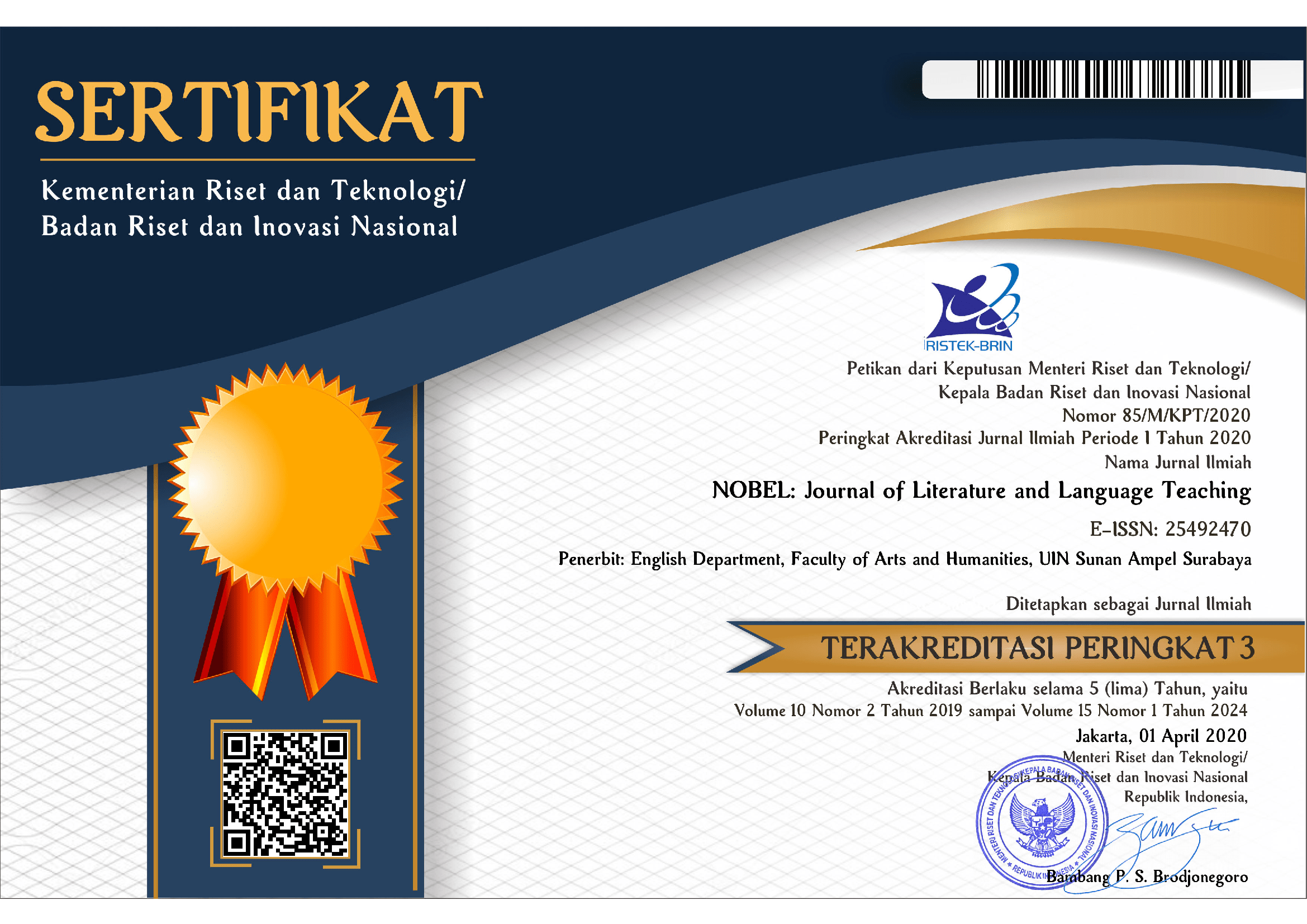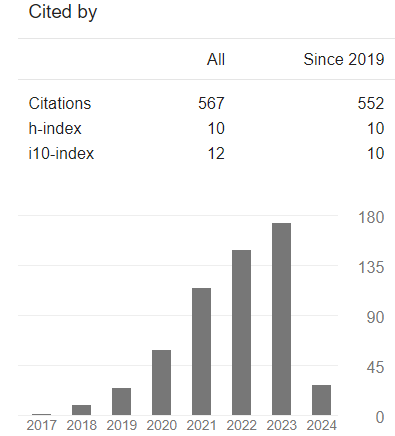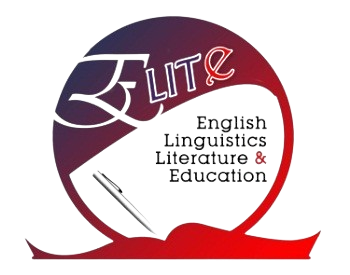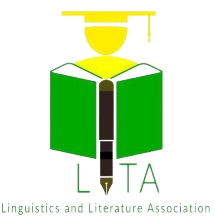Differentiated Instruction for ASD Students in an EFL Class
DOI:
https://doi.org/10.15642/NOBEL.2021.12.2.243-259Abstract
his study aimed to investigate the implementation of Differentiated Instructions (DI) for Autism Spectrum Disorder (ASD) students in an EFL class and investigate the teachers’ views on the use of DI in an EFL class. This study employed a qualitative method and used an observation and interview checklist as the research instruments. Conducted in a private inclusive elementary school in Yogyakarta, Indonesia, this study involved three classes, i.e., grade 2, grade 3, and grade 6, and two English teachers who have experience teaching ASD students in an inclusive classroom setting. The observation and interview showed that DI was implemented in two ways, i.e., the English teachers designed different assessments for ASD students, and 2) the English teachers provided extra assistance for ASD students. The findings indicated that DI helped ASD students accomplish all in-class English assignments, and it helped ASD students follow the language of instructions in the English class. At the end of the article, implications and contributions for both in- and pre-service English teachers who teach ASD students in an inclusive class are offered.
Downloads
References
Aftab, J. (2015). Teachers’ beliefs about differentiated instructions in mixed ability classroom: A case of time limitation. Journal of Education and Educational Development, 2(2), 94–114. http://jmsnew.iobmresearch.com/index.php/joeed/article/view/208
Baxter, A. J., Brugha, T. S., Erskine, H. E., Scheurer, R. W., Vos, T., & Scott, J. G. (2015). The epidemiology and global burden of autism spectrum disorders. Psychological Medicine, 45(3), 601–613. https://doi.org/10.1017/S003329171400172X
Block, M. E., & Zeman, R. (1996). Including students with disabilities in regular physical education: Effects on nondisabled children. Adapted Physical Activity Quarterly, 13(1), 38–49. https://doi.org/10.1123/apaq.13.1.38
Cha, H. J., & Ahn, M. L. (2014). Development of design guidelines for tools to promote differentiated instruction in classroom teaching. Asia Pacific Education Review, 15(4), 511–523. https://doi.org/10.1007/s12564-014-9337-6
Cohen, L., Lawrence, M., & Morrison, K. (2007). Research methods in education (6th Ed.). Routledge.
Dornyei, Z. (2007). Research methods in Applied Linguistics (1st Ed.). Oxford University Press.
Endal, G., Padmadewi, N., & Ratminingsih, M. (2013). The effect of Differentiated Instruction and achievement motivation on students’ writing competency. E-Journal Program Pascasarjana Universitas Pendidikan Ganesha, 1(2013), 1–10. https://doi.org/10.23887/jpbi.v1i0.808
Ernest, J. M., Thompson, S. E., Hull, K. M., & Carter, S. W. (2011). Increasing the teaching efficacy of a beginning special education teacher using Differentiated Instruction: A case study. International Journal of Special Education, 26(1), 191–201. https://files.eric.ed.gov/fulltext/EJ921209.pdf
Greene, S., & Hogan, D. (2005). Researching children’s experience: Approaches and methods (1st Ed.). SAGE Publications Ltd.
Jahan, A., Khan, I. A., & Asif, F. (2017). Relevance of differentiated instructions in English classrooms?: an exploratory study in the Saudi context. International Research Journal of Human Resources and Social Sciences, 4(9), 274–294.
Kapur, R. (2018a). Elementary education in India. https://www.researchgate.net/publication/323695154_Elementary_Education_in_India.
Kapur, R. (2018b). Factors Influencing the Student’s Academic Performance in Secondary Schools in India. https://www.researchgate.net/publication/324819919_Factors_Influencing_the_Students_Academic_Performance_in_Secondary_Schools_in_India
Kurniawati, L. A. (2020). Personalized learning: Empowering a student with autism spectrum disorder in Basic Grammar course. Yavana Bhasha: Journal of English Language Education, 1(1), 1-11. https://doi.org/10.25078/yb.v1i1.1372
Kurniawati, L. A., Kristen, U., & Wacana, D. (2019). Leveraging technology-enhanced personalized learning to empower a student with autism spectrum disorder. Proceedings of The 7th OpenTESOL International Conference, Vietnam, 14–26.
Mach?, E. (2015). Analyzing Differentiated Instructions in inclusive education of gifted preschoolers. Procedia - Social and Behavioral Sciences, 171(2015), 1147–1155. https://doi.org/10.1016/j.sbspro.2015.01.224
Marlina, M., & Efrina, E. (2019). Differentiated learning for students with special needs in inclusive schools. Proceedings of the 5th International Conference on Education and Technology (ICET 2019), 678-681. https://doi.org/10.2991/icet-19.2019.164
Morley, D., Bailey, R., Tan, J., & Cooke, B. (2005). Inclusive physical education: Teachers’ views of including pupils with special educational needs and/or disabilities in physical education. European Physical Education Review, 11(1), 84–107. https://doi.org/10.1177%2F1356336X05049826
Nordlund, M. (2003). Differentiated Instruction: Meeting the needs of all students in your classroom. Lanham: Scarecrow Education.
Otanjac, M. I. (2016). Students with language learning disabilities and difficulties in a foreign language classroom. Specijalna Edukacija i Rehabilitacija, 15(4), 461–474. https://doi.org/10.5937/specedreh15-12071
Padmadewi, N. N., & Artini, L. P. (2017). Teaching English to a student with Autism Spectrum Disorder in regular classroom in Indonesia. International Journal of Instruction, 10(3), 159–176. https://www.e-iji.net/dosyalar/iji_2017_3_11.pdf
Park, Y., & Thomas, R. (2012). Educating English-language learners with special needs: Beyond cultural and linguistic considerations. Journal of Education and Practice, 3(9), 52–59. https://www.iiste.org/Journals/index.php/JEP/article/view/2285
Roberts, J. M. A., & Williams, K. (2016). Autism spectrum disorder: Evidence-based/evidence-informed good practice for supports provided to preschool children, their families and carers. National Disability Insurance Agency. http://a4.org.au/sites/default/files/Autism%20Research%20Report%20final.pdf
Robertson, K., Chamberlain, B., & Kasari, C. (2003). General education teachers’ relationships with included students with Autism. Journal of Autism and Developmental Disorder, 33(2), 123-130. https://doi.org/10.1023/A:1022979108096
Ryan, C., & Quinlan, E. (2017). Whoever shouts the loudest: Listening to parents of children with disabilities. Journal of Applied Research in Intellectual Disabilities, 31(S2), 203–214. https://doi.org/10.1111/jar.12354
Santrock, J. W. (2018). Educational Psychology. (6th Ed.). New York: McGraw-Hill Education
Shareefa, M., Zin, R. H. A. M., Abdullah, N. Z. M., & Jawawi, R. (2019). Differentiated Instruction: Definition and challenging factors perceived by teachers. Proceedings of the 3rd International Conference on Special Education (ICSE 2019), 322–327. https://www.atlantis-press.com/proceedings/icse-19/125928885
Siam, K., & Al-Natour, M. (2016). Teacher’s Differentiated Instruction practices and implementation challenges for learning disabilities in Jordan. International Education Studies, 9(12), 167-181. https://doi.org/10.5539/ies.v9n12p167
Simeonsson, R. J., Carlson, D., Huntington, G. S., McMillen, J. S., & Brent, J. L. (2001). Students with disabilities: A national survey of participation in school activities. Disability and Rehabilitation, 23(2), 49–63. https://doi.org/10.1080/096382801750058134
Singal, N. (2016). Education of children with disabilities in India and Pakistan: Critical analysis of developments in the last 15 years. Prospects, 46(1), 171–183. https://doi.org/10.1007/s11125-016-9383-4
Stafford, L. (2017). 'What about my voice': Emancipating the voices of children with disabilities through participant-centered methods. Children’s Geographies, 15(5), 600–613. http://dx.doi.org/10.1080/14733285.2017.1295134
Subekti, A. S. (2020). Self-made vocabulary cards and differentiated assessments to improve an autistic learner’s English vocabulary mastery. International Journal of Education, 13(1), 8–17. https://doi.org/10.17509/ije.v13i1.22587
Thanh, N. C., & Thanh, T. T. L. (2015). The interconnection between interpretivist paradigm and qualitative methods in education. American Journal of Educational Science, 1(2), 24–27. http://files.aiscience.org/journal/article/html/70380008.html
Tomlinson, C. A. (2000). Differentiation of instruction in the elementary grades. ERIC Digest, 1–7. https://files.eric.ed.gov/fulltext/ED443572.pdf
Tomlinson, C. A. (2001). How to differentiate instruction in mixed-ability classrooms. (2nd Ed.). Alexandria: Association for Supervision and Curriculum Development (ASCD).
Valiandes, S. (2015). Evaluating the impact of differentiated instruction on literacy and reading in mixed ability classrooms: Quality and equity dimensions of education effectiveness. Studies in Educational Evaluation, 45(2015), 17–26. https://doi.org/10.1016/j.stueduc.2015.02.005
Valvi, N., Sonawane, S., & Jadhav, P. (2020). Preparing inclusive class for the children with special needs during COVID -19 crisis. Educational Quest: An Int. J. of Education and Applied Social Science, 11(3), 183–187. https://doi.org/10.30954/2230-7311.3.2020.5
Downloads
Published
How to Cite
Issue
Section
License
Copyright (c) 2021 NOBEL: Journal of Literature and Language Teaching

This work is licensed under a Creative Commons Attribution 4.0 International License.







